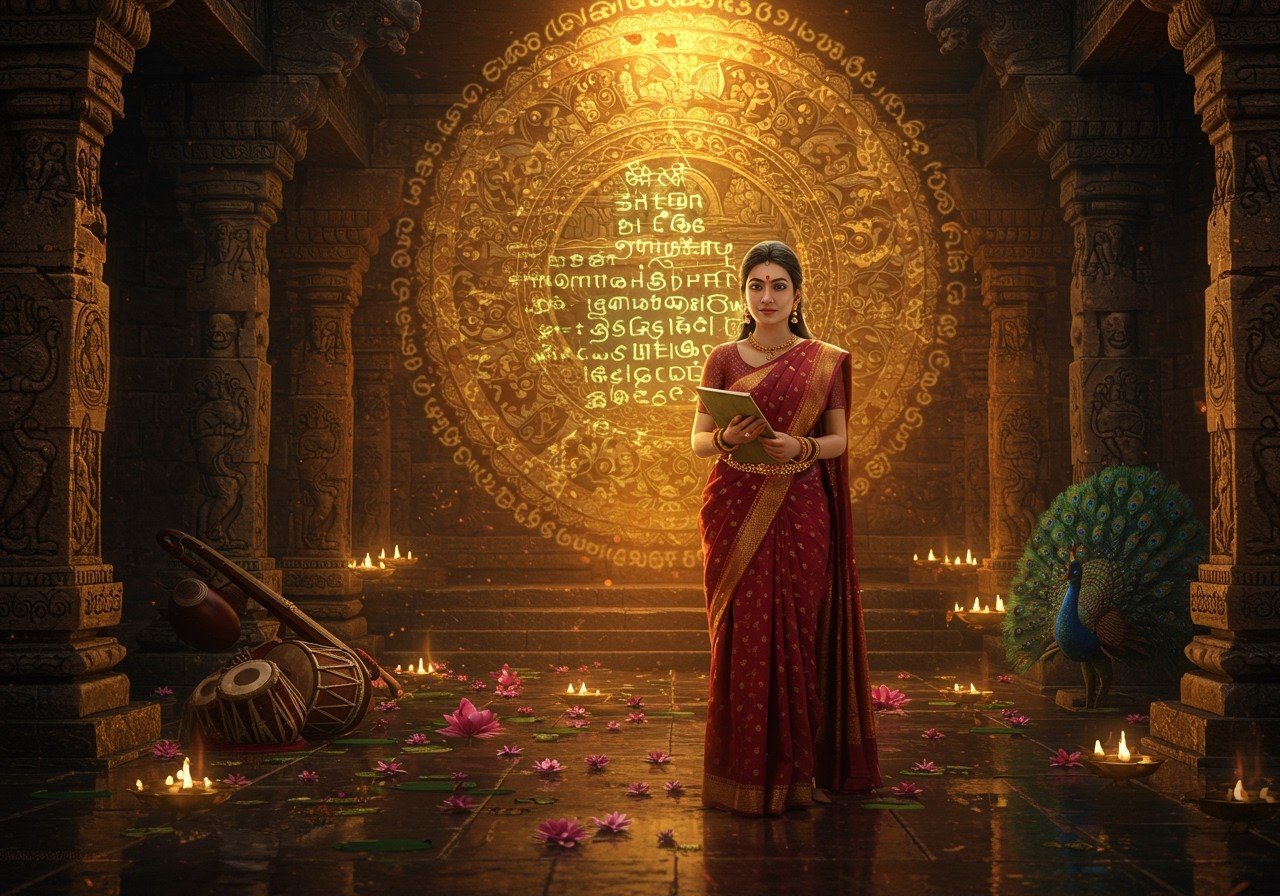
Sangam literature, historically known as ‘the poetry of the noble ones,’ offers a captivating glimpse into the lives, culture, and beliefs of the Tamil people from approximately 300 BCE to 300 CE. This blog provides a beginner-friendly exploration of Sangam Literature, discussing its origins, structure, and significance in Indian heritage. It includes around 2381 poems attributed to 473 poets and works by 102 anonymous poets. The Sangam Age, covering the same period, is notable for its gatherings of poets and scholars. The oldest extant Tamil work is the Tolkappiyam, a treatise on Tamil phonology, morphology, syntax, and poetics, dating to around 300 BCE.
What is Sangam Literature?
Sangam literature, also known as ‘Sangam poetry,’ represents the earliest known classical Tamil literature. It comprises a vast collection of poems and songs composed by numerous poets.
- Sangam refers to the Tamil academies (assemblies) where poets and scholars gathered to share and critique literary works. These gatherings played a crucial role in shaping and preserving Tamil literary traditions.
- These academies were purportedly held in the ancient Tamil cities of Madurai and Korkai, though the exact locations and details of the first two Sangams remain largely shrouded in legend.
- The literature is categorized into three main Sangams: the First Sangam, the Second Sangam, and the Third Sangam. Of these, only the Third Sangam has extant works available for study today.
- The Third Sangam is the most prominent and well-documented, with the majority of surviving Sangam literature attributed to this period. It is considered the golden age of classical Tamil literature.
- Sangam literature is broadly classified into two categories: ‘Aham’ (subjective) and ‘Puram’ (objective). ‘Aham’ delves into personal and interior themes like love, romance, and domestic life, while ‘Puram’ explores exterior themes such as war, politics, and public life.
- This rich body of literature provides valuable insights into various aspects of ancient Tamil society, including their ethics, social structures, religious beliefs, and their intimate relationship with the natural world.
Sangam Literature in Education (Class 6)
In India, Sangam Literature is introduced to students in Class 6 as part of their history curriculum. This introduction aims to familiarize young learners with their rich literary heritage.
- Students learn about the historical significance of Sangam Literature in understanding early Tamil culture and the evolution of the Tamil language. This helps them connect with their roots and appreciate the depth of their cultural heritage.
- Textbooks highlight key works such as ‘Thirukkural,’ ‘Silappatikaram,’ and ‘Manimekalai,’ introducing students to the literary masterpieces of the Sangam period. They learn about the authors, themes, and historical contexts of these works.
- The curriculum emphasizes the universal themes of love, valor, and social values found in these works, promoting ethical development and an understanding of human nature across time.
- Lessons often incorporate excerpts from famous poems to illustrate literary styles, themes, and the use of figurative language. This helps students develop their literary analysis skills and appreciate the beauty of ancient Tamil poetry.
- Teachers use these texts to discuss the daily life, trade, social hierarchies, and political structures of the time, painting a vivid picture of ancient Tamil society.
- Students are introduced to prominent poets of the Sangam period, such as Thiruvalluvar, Kapilar, and Avvaiyar, fostering an appreciation for the individuals who shaped Tamil literature.
Key Characteristics of Sangam Literature
Sangam Literature possesses distinct characteristics that set it apart:
- Brevity and Emotional Depth: The poems are often concise yet powerfully evocative, expressing complex emotions in a few carefully chosen words. This demonstrates the skill of the poets in conveying profound meaning with economy of language.
- Figurative Language: The use of metaphors and similes is prevalent, enriching the poetic expression and creating vivid imagery. This stylistic feature adds depth and complexity to the poems.
- Nature Imagery: Nature imagery is a significant element, with landscapes often symbolizing human emotions and experiences. The natural world is deeply intertwined with human life in Sangam literature.
- Secular Focus: The poetry is largely secular, primarily focusing on human experiences rather than religious themes. This distinguishes it from many other ancient literary traditions.
Significance and Major Works
Sangam Literature holds immense significance:
- It provides a valuable record of early Tamil civilization. Works like the Tolkappiyam offer insights into the language’s structure and early literary conventions.
- It is a rich source of information on ancient Tamil society, covering aspects like social hierarchy, customs, and daily life.
Major works include:
- Thirukkural by Thiruvalluvar: A timeless collection of couplets on ethics, politics, and love, offering guidance on virtuous living.
- Silappatikaram by Ilango Adigal: An epic poem narrating the tragic tale of Kannagi and Kovalan, exploring themes of justice, love, and fate.
Poojn.in: Connecting You to Sangam Heritage
Poojn.in, India’s leading online store for cultural and religious goods, offers a wide selection of products that can enhance your exploration of Sangam literature and its associated traditions. Explore our collection of puja items, books, and traditional crafts here.
For those interested in delving deeper into the spiritual aspects of Sangam literature, particularly the worship of Lord Murugan, we offer a curated selection of items:
- Vel: Find exquisitely crafted brass and copper Vel (sacred spear), a symbol associated with Lord Murugan, in various sizes to suit your altar or personal shrine. Explore our Vel collection.
- Traditional Lamps: Illuminate your puja space with authentic Kuthuvilakku (traditional oil lamps), perfect for daily prayers and creating a sacred ambiance. Browse our lamp selection.
Explore our extensive collection of puja items, sacred texts, and traditional crafts to enrich your understanding and appreciation of Sangam literature and its enduring legacy. Visit poojn.in today.


